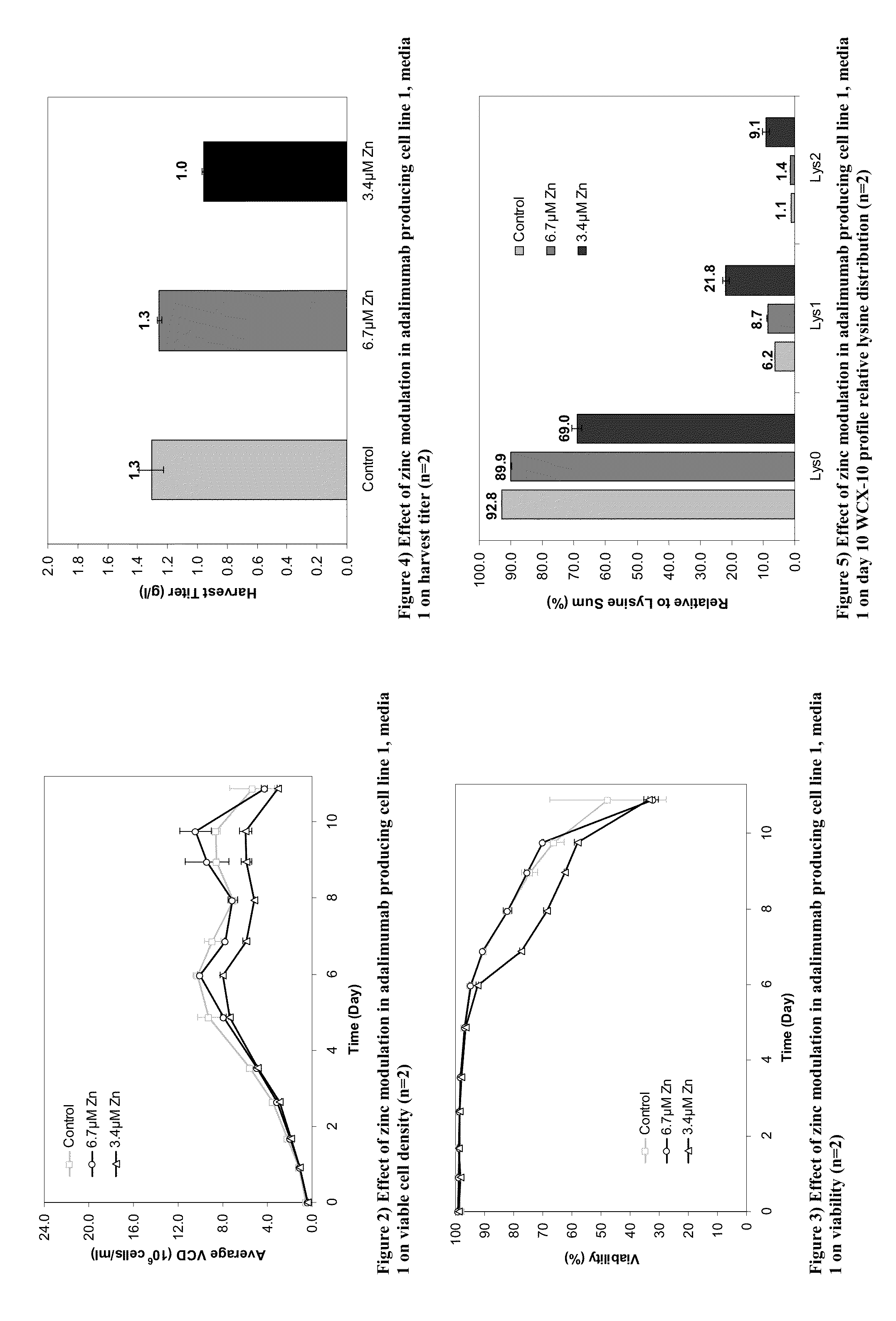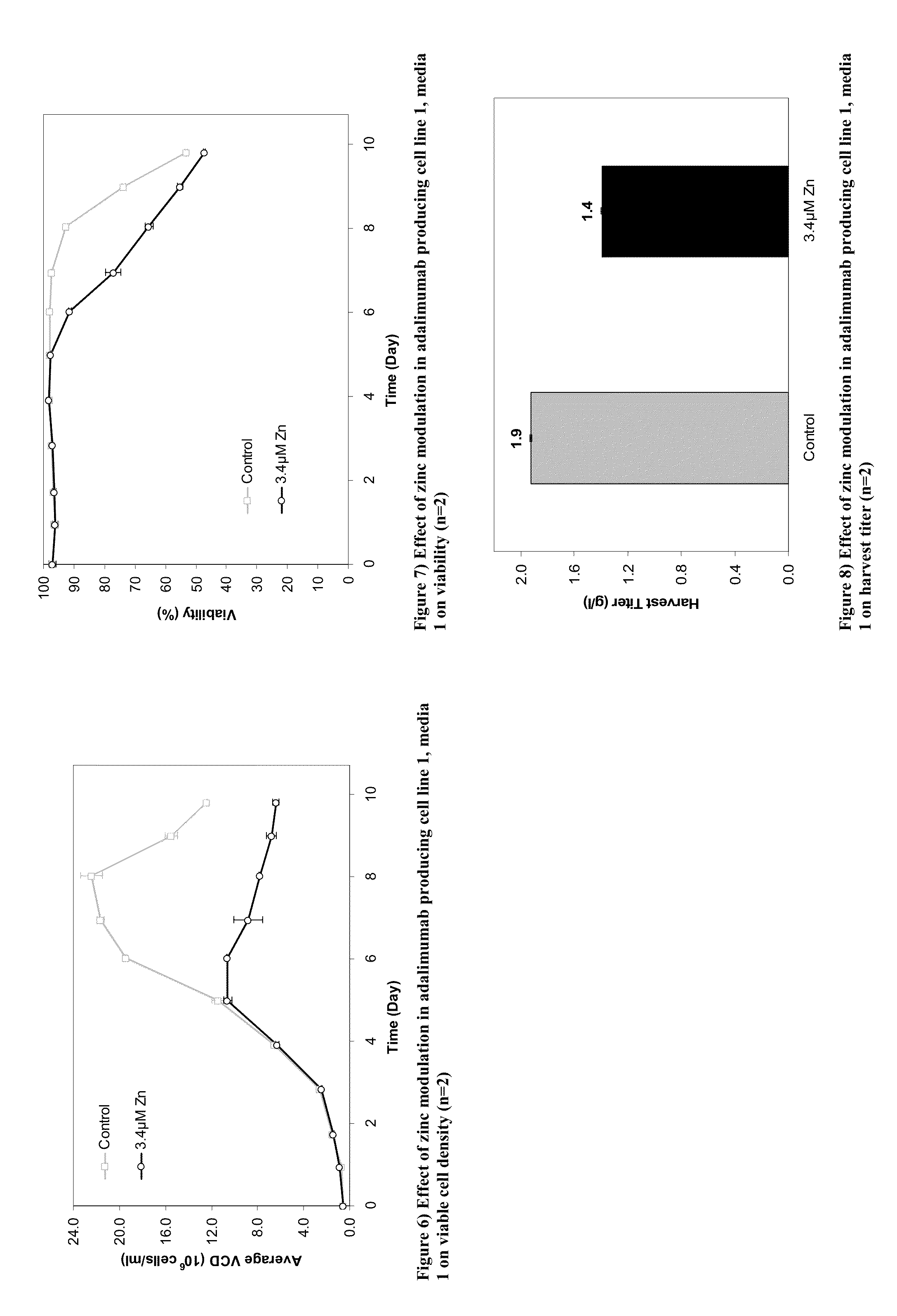Modulated lysine variant species compositions and methods for producing and using the same
a technology of lysine variants and compositions, applied in the direction of immunoglobulins, peptides, antibody medical ingredients, etc., can solve the problems of reducing product efficacy and stability or just the opposite, and achieve the effects of reducing cartilage destruction, increasing cartilage penetration, and increasing the efficacy of treating or preventing diseases
- Summary
- Abstract
- Description
- Claims
- Application Information
AI Technical Summary
Benefits of technology
Problems solved by technology
Method used
Image
Examples
example 1
Methods for Modulating the Lysine Variant Distribution in Cell Culture by the Modulation of Zinc Concentration in Culture Medium
[0417]This Example provides methods to modulate the lysine variant distribution of monoclonal antibodies by modulating the levels of zinc in the medium.
[0418]Materials and Methods
[0419]Cell Lines and Adaptation Cultures
[0420]Two adalimumab producing cell lines were employed in the studies discussed herein (cell line 1 and cell line 2). Upon thaw, cells were typically cultured in a combination of 250 ml and 500 ml Corning vented non-baffled shake flasks on a shaker platform at 110 RPM for cell line 1 and 180 rpm for cell line 2 in a 35° C., 5% CO2 incubator. Subsequent to the initial cell growth in the standard IVGN CD basal growth media, cells were adapted for two passages in separate flasks in basal media containing different concentrations of zinc. Only the cultures that demonstrated good cell growth in the adaptation phase were carried forward to the pro...
example 2
Methods for Modulating the Lysine Variant Distribution in Cell Culture by the Addition of Amino Acids
[0437]This Example provides methods to modulate the lysine variant distribution of monoclonal antibodies by supplementing amino acids (arginine, lysine, and histidine added individually and ornithine in combination with arginine, lysine and / or histidine) to the cell culture medium.
[0438]Materials and Methods
[0439]Cell Source and Adaptation Cultures
[0440]Three adalimumab producing cell lines (cell line 1, cell line 2, and cell line 3), one mAb1 producing cell line and one mAb2 producing cell line were employed in the experiments described in this Example.
[0441]For adalimumab producing cell lines, cells were cultured in their respective growth media (chemically defined media (media 1) or a hydrolysate based media (media 2 or media 3)) in a combination of vented non-baffled shake flasks (Corning) on a shaker platform at 110 RPM (cell line 1), 180 RPM (cell line 2), 140 RPM (cell line 3)...
example 3
Methods for Modulating the Lysine Variant Distribution in Cell Culture by Adjusting Process Parameters
[0492]Materials and Methods
[0493]Cell Source and Adaptation Cultures
[0494]Three adalimumab producing CHO cell lines (call line 1, cell line 2, and cell line 3) were employed in the studies in this Example.
[0495]For adalimumab producing cell lines, cells were cultured in their respective growth media (chemically defined media (media 1) or a hydrolysate based media (media 2 or media 3)) in a combination of vented non-baffled shake flasks (Corning) on a shaker platform at 110 RPM (cell line 1), 180 RPM (cell line 2), 140 RPM (cell line 3) and 10 L or 20 L wave bags (GE). For experiments with cells in the hydrolysate based media (media 3), cells were thawed in media 1 and then adapted to media 3 over a few passages. Cultures were propagated in a 35° C., 5% CO2 incubator for cell line 1 and 2 and in a 36° C., 5% CO2 incubator for cell line 3 in order to obtain the required number of cell...
PUM
| Property | Measurement | Unit |
|---|---|---|
| temperature | aaaaa | aaaaa |
| stability | aaaaa | aaaaa |
| heterogeneity | aaaaa | aaaaa |
Abstract
Description
Claims
Application Information
 Login to View More
Login to View More - R&D
- Intellectual Property
- Life Sciences
- Materials
- Tech Scout
- Unparalleled Data Quality
- Higher Quality Content
- 60% Fewer Hallucinations
Browse by: Latest US Patents, China's latest patents, Technical Efficacy Thesaurus, Application Domain, Technology Topic, Popular Technical Reports.
© 2025 PatSnap. All rights reserved.Legal|Privacy policy|Modern Slavery Act Transparency Statement|Sitemap|About US| Contact US: help@patsnap.com



